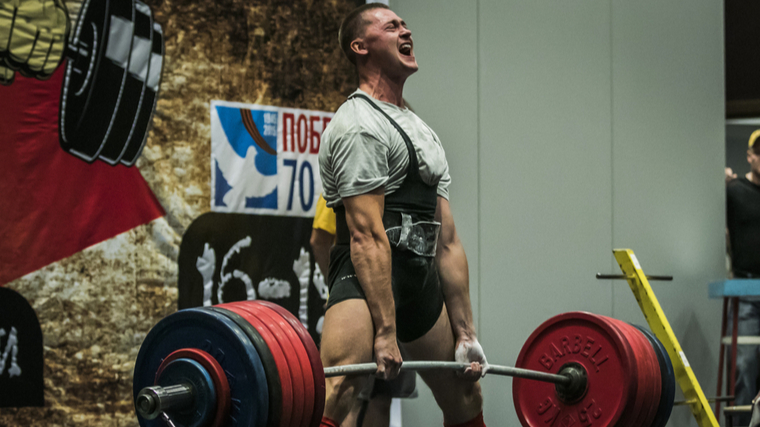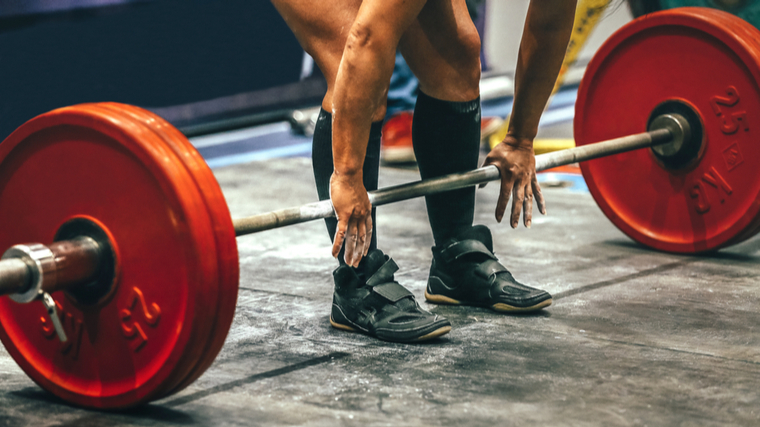The deadlift is one of the most empowering movements you can do with a barbell. Some of the most inspiring feats of strength ever performed involve a picture-perfect pull from the floor. If you have a personal goal of pulling 500 pounds — or more — off the ground, it can be tempting to seek out a shortcut to that magic number.

Alas. Deadlifting heavy takes time, consistent practice, and a balanced approach to training. It’s about more than just loading up extra plates — you’ve got to focus on your nutrition, sleep, and stress management, too.
This article will walk you through programming theory, nutrition and recovery guidelines, mental tips, and serve as a blueprint to help you finally put five wheels on the bar.
- Deadlift Techniques
- Programming Heavy Deadlifts
- Nutrition for Deadlifting
- Recovery for Deadlifting
- Deadlift Cues and Tips
Deadlift Technique — Sumo vs. Conventional
The first step towards achieving a five-plate pull is getting the technique down. Opting for sumo style or conventional form will require an assessment of your mobility as well as some practical trial and error, but getting it right early on can accelerate your journey to the lift you’ve always wanted.
The Sumo Deadlift
The sumo deadlift may be more suitable for you if you have long legs. Tall trainees can sometimes struggle to compact themselves into an advantageous posture on the conventional pull, so getting the legs out of the way is beneficial. The sumo deadlift also generally comes with a smaller range of motion, but at a cost — the requisite mobility, particularly in the hips, is very high.
The Conventional Deadlift
The standard barbell deadlift can be performed by any athlete, but lends itself well to stockier builds and shorter legs. Since the hips tend to sit lower and further away from the barbell, conventional pullers may need more back strength and stability than sumo pullers. The trade-off is that the technique is more straightforward and conventional pulls are generally easier to grind through.
Programming To Deadlift 500 Pounds
Your deadlifting goal might be your own body weight, or it might be 500 pounds. Whatever the case, you’ll need a solid program to help you get there. The good news is, there are plenty of training options to choose from when you’re programming to build max strength.
If you want to pull big in the gym, remember that you’ll have to make concessions elsewhere. You’ll still want to squat, overhead press, and bench, but they may have to take a back seat while you focus on developing your deadlift.
Linear Progression
One of the most popular forms of periodization is linear progression — a gradual, incremental, and consistent increase in the weight on the bar over a period of time. Each week, you’ll increase the weight used in your deadlift by five to 10 pounds. Proceed until you can’t complete your prescribed reps with perfect form or add additional weight. This indicates it may be time to move on to a different style of programming or take a brief deload.
[Read More: The Most Effective Workout Splits, Created by Our Experts]
A common misconception is that linear progression is only suitable for rank beginners. While it is true that the gains come easy in your first few years in the gym, intermediate and sometimes even advanced trainees can benefit from linear progression to some degree. After all, you can add up to 40 pounds a month to your deadlift — not an insignificant sum by any means!
Conjugation
The core idea of conjugation as a training style is to constantly vary the exercises and implements used so that you can minimize the effects of overtraining and keep the body primed for gaining strength and muscle.
Additionally, by constantly varying the movements, you are able to make the training stimulus more transferable to other environments. This may mean playing more with pulling variations, bands, chains, fat bars, trap bars, or entirely opting to perform other lifts outside the “deadlift family”. All of these variations can be very effective means of improving overall strength adaptation and progress, which then bleeds into your deadlift itself.
Daily Undulation
It might be tempting to only pull lighter weights at very high volume to get stronger. While performing 10 sets of 10 deadlifts for hypertrophy, or doing countless repetitions in a WOD may sound like a good idea, the ability to lift heavy things is a skill that the nervous system and brain regulate, not the muscles themselves.

[Read More: Powerbuilding Workout Routine, With Tips from a CPT]
Daily undulation is a means of getting in high-quality practice without frying your neurons week after week. The principle of undulation involves changing intensities on the same exercise session by session — think a “light” day, a “moderate effort” day, and one day where you go all-out for a few singles or doubles.
Eating For Progress
If you want to be able to pull heavy, you need to eat like you mean it. While that doesn’t necessarily mean you need to go all Hafthor Bjornsson on your grocery list, if you want to build the muscle and strength needed to achieve an impressive max, you need enough nutrients and calories.
Even if you’re looking to lose fat while building muscle, pay attention to tracking your macros. Focus on timing your nutrient intake for maximum muscle recovery so you can come back and lift heavy on a regular basis.
Recovery and Stress Management
When your goal is getting strong, you need to make recovery just as important as your lifting. Even if you program long training sessions for yourself, you likely spend overwhelmingly more time outside the gym than in it. That’s 22 out of 24 hours (for example) that you’re recovering from your sessions — why shouldn’t it be taken just as seriously as loading up the barbell?
Optimize Your Sleep
Everyone needs a solid amount of sleep — think seven to nine hours — each night to function at their best. Think seven to nine full hours for most people. But when you’re an athlete and training to lift your best, you might need even more.

Everyone, especially lifters, needs a solid dose of sleep each night. Seven to nine hours of shut-eye ensures that you physiologically recover from training stressors, but also comes with the perk of elevating growth hormone levels. Little changes like reducing screen time at night or limiting caffeine intake in the afternoon can go a long way towards improving your deadlift.
Minimize Your Stress
Stress is, unfortunately, part of life. You’ve got to pay rent; when there’s a new baby in the house, you’ve got to be up at all hours making sure they get fed; on and on. But if you want to deadlift better, minimizing stress as much as possible is crucial.
Heavy lifting is a stressor in and of itself. If your cup is already full when you go to the gym, pouring more on may create some nasty spillover. Beyond establishing healthy personal boundaries at work or in the home, practices like meditation or yoga can be a good way to clear the mind so you can zone in at the gym. Lifestyle adjustments are as much a part of training as the training itself.
Program Active Recovery Days
You might want to go hard every day — but that’s not necessarily what’s best for your body or your gains. Instead, consider programming at least one active recovery day per week.
These training days won’t see you hitting heavy weights, but you’ll still be moving your body. Light exercise will help flush toxins, ease muscle soreness, and give your brain the mental break you need from all those heavy weights.
Warm Up and Cool Down
It doesn’t have to be a formal active recovery day to focus on your overall muscular health. Diving right into your workout — and leaving the gym without cooling down — can eat into your gains in a big way.
Make sure you’re including a full dynamic warmup into each lifting session if you really want to get stronger. You’ll help your body remain resilient against injury, and you’ll fire up all the muscles you need to get solid work done.
Once you’re done pulling for the day, make sure you’re cooling down before you leave the gym. You’ll be setting your muscle recovery up for success, easing your mental transition away from the weights, and improving your mobility for the next session as well.
Deadlift Tips, Tricks, and Cues
Pulling a heavy barbell goes beyond the mechanics themselves. The right cues can help you engage more muscle, work with your body type instead of against it, and improve your confidence no matter how much weight is in your hands.
Set Your Feet
Without firm footing, you are doomed. When setting up, take the time to “screw” your feet into the floor. Make sure that your entire foot has equal pressure against the floor. Try to think about gripping the floor with your toes — an active foot can help the legs work harder under load.
Never Stop Pulling
Heavy deadlifts move slowly, whether you’re attempting a PR or not. An effective way to bust through a sticking point is to commit to pulling the whole way. Once you clear your sticking point, whether it is off the floor or just past the knees, it is crucial to keep your foot on the gas until your hips have punched into lockout.
Don’t Rush It
There is a big difference between attacking a weight and being hasty. Whether you’ve got a single plate on the bar or a lifetime personal best, it is imperative to be patient and methodical from your setup to your lockout. The more you practice a ritualistic pre-lift procedure, especially on warm-up sets, the more automatic it becomes. When you go to pick up the heaviest deadlift of your life, the only thing on your mind should be pulling as hard as you can.
Final Word
There are no shortcuts to a heavy deadlift, so don’t be afraid to take your time. That said, pulling with the style that suits your body, picking the right program, eating well and sleeping soundly can speed up your journey.
Recognizing the intense demands that the deadlift places on your system will help you respect both your body and the lift itself. Resist the urge to stroke your ego and you’ll have five plates — or more — on the bar in no time.
Featured Image: Sportpoint / Shutterstock